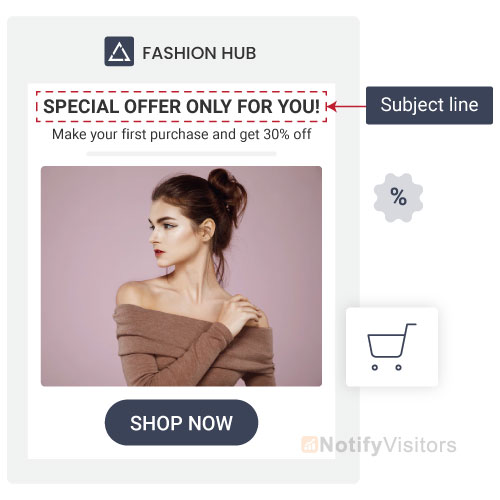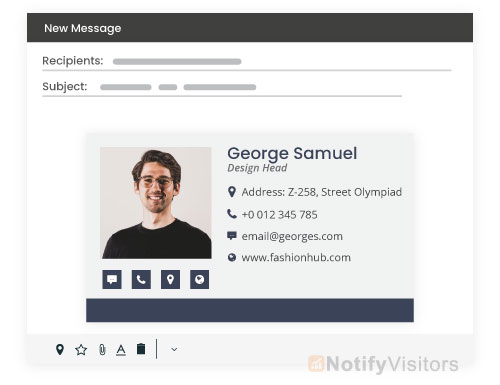Are you looking for ways to make your emails stand out in 2025? It’s time for a refresh! Designing an email that is visually pleasing, easy to read, and engaging can be challenging. But don’t worry — there are several best practices that you can follow when designing emails this year.
In this post, we’ll be exploring 16 tried-and-true email design best practices so you can create professional and beautiful-looking emails that captivate your readers.
From organizing the content with headlines and subheadings to making sure text sizes are legible on all devices, these strategies will help you craft well-designed emails that capture attention and get results. So let’s dive right in!
Contents
15+ Email Design Best Practices
1. Craft a strong subject line

This is one of the email design best practices as your email subject line is the first thing anyone notices when you send them an email. The brief statement is supposed to pique your recipients’ interest. It should grab their attention so they want to open your email and read it further.
A great subject line will have these characteristics:
- Capture the attention of your readers in as few words as possible.
- Deliver value for the recipient that makes them want to open the email.
- Summarize what recipients will read and learn once they open the email.
2. Preheader
With a good email preheader or preview text, readers may fully understand what you’re trying to say. Preheader serves as an extension to your subject line. Hence, it should explain the value proposition further and convince people to open the email.
Follow these tips to make a good preheader
- Not more than 70 characters and not lesser than 30 characters
- Personalize it just like you would other email elements
- Please don’t repeat the subject line and make it relevant to it
- It should offer value, drive interest, or context
- Make sure it is mobile-friendly.
3. Sender Name
Usually ignored, the sender’s name is a crucial element of any email design. 68% of Americans determine whether or not to open an email simply by reading who sent it.
Why is it so crucial? The sender’s name adds credibility to the email and makes the reader interested enough to open it. There’s no one-size-fits-all method for picking the right sender name. However, make sure to keep it personal, relevant, and short.
One novice mistake while sending emails is solely by your staff’s name. Readers who don’t recall a name will likely move the email to the spam folder. For instant recall, you can add their staff’s name only when connected with the company’s name.
4. Keep your email on-brand.
When your email recipients open your message, they should learn the email was sent from your company. Telling your email should be branded.
To keep your email on-brand, consider utilizing the following tactics:
- Use a tone in your emails that go with your other content and marketing materials (like your website and social media).
- Include the same colors and fonts used in your other branding and marketing materials.
- Incorporate your logo, a link to your website, social media accounts, and calls-to-action (CTAs) relevant to your products or services. This is a great way to improve brand awareness while also facilitating conversions.
5. Use the layout to enhance your email’s user experience.
Nobody likes to read a messy and unorganized email — this overwhelms recipients and can lead to higher abandonment. Instead, organize your layout while keeping user experience (UX) in mind — leave empty/ white space and strategically position your written and visual content, so it’s organized and effortless to consume and navigate. You can also use SharePoint Forms which can help you find best practices to enhance your user experience and functionality.
6. Use GIFs

When you have a choice between video and GIFs, always prefer GIFs. Because only a few email clients permit embedded videos, you are more likely to end up in the spam.
So it’s advisable to use GIFs in the email instead of videos as they are short, vibrant, and take less time to load. Make sure the GIF you use is compressed and is not a large file; this will help with the deliverability.
7. Footer
An email’s footer is as significant as its other elements. Readers usually look at the footer for actionable information, like contact details and social media profiles. It should also contain a link to unsubscribe from receiving future emails.
Email marketers commonly ignore the footer, which offers an opportunity to generate maximum utility. Get creative with them and consider including the following suggestions;
- Unique selling proposition
- Core brand values
- Company slogan
- Store location
- Coupon code
8. A/B Testing
You might believe your email design is amazing, but your readers may have different views. You never understand how your audience will perceive a particular email. Hence, the performance of emails should be observed through A/B testing.
You can be an experienced email marketer to execute A/B testing. Just follow the easy steps below;
- Make two email designs with differing elements, like CTA, color palette, and video. We suggest testing a single variable at a time.
- Send the first email to one-half of your audience and the second to the other half.
- Measure which email gives the expected results.
- Continue testing for other variables.
9. Personalize every email

Customizing an email and tailoring it to your recipient will make you feel more competent, professional, and personal. Email personalization also enables you to humanize your brand. This touch helps foster a relationship between your business and email recipients and boost retention rates.
10. Avoid sending all-image emails.
Avoid sending emails that contain just images. It’s a bad practice that confuses readers if the images do not load. Also, it makes emails not accessible for people who have disabilities and utilize screen readers.
Try to keep the image-to-text ratio at 40:60 and bypass image-based text. If you can’t, provide a fallback with alt text so the email is precise if the images don’t load. An email width of 600-640 px is optimal to ensure it looks fine on all devices. So keep it in mind when adding images and creating the template.
11. Responsive for all devices
People usually check their emails on the phone when they are not operating a laptop. So you must design emails that are responsive regardless of the device. To make your email design responsive, keep the email copy concise and legible so people can read it on the go.
You can also design it, so the links and CTAs are within thumb reach. If your message is long, consider repeating the primary CTA at the end of the copy to save your reader’s scrolling time.
12. Colours
The overall colour palette of an email plays a vital part in how it is perceived. Your emails will be less than an eyesore if pleasant colours are not chosen. So you can leverage Canva design service for creating visually appealing email templates with harmonious color schemes that capture the attention of your audience.
Keep the following tips in mind while choosing colours.
- Determine a palette of your brand’s colours and stick to them. You can incorporate other colours, but the primary focus should be on the defined palette.
- Highlight sections utilizing a contrasting colour to the background colour.
- Do not go overboard with utilizing multiple colours in an email. Remember, you’re striving for a powerful email, not a rainbow sundae. Three colours are sufficient.
- The background and text colours should blend well. Having a white background with red-coloured text just looks horrible.
13. Add an “unsubscribe” button.
Email marketing is highly effective if you deliver relevant content to your recipients. The sad but true reality of email marketing is that your recipients and customers vary over time — particularly as your business expands and evolves. Therefore, your content may not always apply to specific audience members.
For this reason, let your recipients leave (or unsubscribe from your emails) on a good note so they can recall your business positively.
They may require your email content, products, or services again. To do this, facilitate their lives with an easy-to-use and visible “unsubscribe” button. In addition to delivering a better user experience, you’re mandated by law to add that unsubscribe button.
14. Dark mode
Almost 80% of people utilize dark mode on their devices. So it’s essential your email design works well with it. Ensure that the font shifts to a light colour on the dark background and that all the optical components are properly visible for a dark or light background.
15. Design an email signature

Great email signature design is another way to create a professional and personal feel over email. Email signatures shouldn’t just contain your name — they should have other defining and memorable characteristics about you, your role, contact information, and your company.
Here are some specifics you can add to your email signature:
- First and last name
- Contact information (and secondary contact information)
- Job Title / Role
- Company Name
- Link to your meeting calendar
- Social media links (e.g. LinkedIn profile)
- Pronouns
- Photo
- Industry disclaimer or legal requirements
16. Keep the overall email design minimal.
When you check the email’s final review, remove any duplicative or unnecessary information or design element. When designing the email, adhere to the concept that less is more, as a lengthy and cluttered email only prevents the readers from reading your content.
Conclusion
Email design is constantly evolving, as new technologies and user behaviors shape the way we interact with email. By following these 16 email design best practices, you can make sure your emails are on trend in 2025 and beyond.
From interactive elements to personalized content, there’s a lot to consider when designing your next email campaign. But if you keep these practices in mind, you’ll be well on your way to success.
Also Read:
- Saas Onboarding Emails: Example, Templates & Best Practices
- What is Opt in Email? Definition, Examples and Best Practices
- Email Design: Examples & Best Practices {Ultimate Guide}
- 14 Best Email Marketing Platforms [Features & Pricing Compared]
- 21 Cheap Email Marketing Software [Compared]

























 Email
Email SMS
SMS Whatsapp
Whatsapp Web Push
Web Push App Push
App Push Popups
Popups Channel A/B Testing
Channel A/B Testing  Control groups Analysis
Control groups Analysis Frequency Capping
Frequency Capping Funnel Analysis
Funnel Analysis Cohort Analysis
Cohort Analysis RFM Analysis
RFM Analysis Signup Forms
Signup Forms Surveys
Surveys NPS
NPS Landing pages personalization
Landing pages personalization  Website A/B Testing
Website A/B Testing  PWA/TWA
PWA/TWA Heatmaps
Heatmaps Session Recording
Session Recording Wix
Wix Shopify
Shopify Magento
Magento Woocommerce
Woocommerce eCommerce D2C
eCommerce D2C  Mutual Funds
Mutual Funds Insurance
Insurance Lending
Lending  Recipes
Recipes  Product Updates
Product Updates App Marketplace
App Marketplace Academy
Academy

